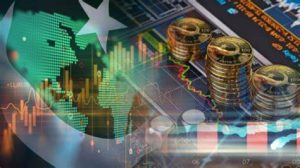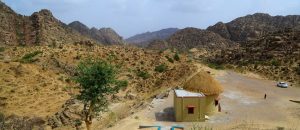Decades of internal political disputes and low levels of foreign investment have led to underdevelopment in Pakistan. Pakistan has a large English-speaking population, with English-language skills less prevalent outside urban centers. Despite some progress in recent years in both security and energy, a challenging security environment, electricity shortages, and a burdensome investment climate have traditionally deterred investors. Agriculture accounts for one-fifth of output and two-fifths of employment. Textiles and apparel account for more than half of Pakistan’s export earnings; Pakistan’s failure to diversify its exports has left the country vulnerable to shifts in world demand. Pakistan’s GDP growth has gradually increased since 2012, and was 5.3% in 2017. Official unemployment was 6% in 2017, but this fails to capture the true picture, because much of the economy is informal and underemployment remains high. Human development continues to lag behind most of the region. In 2013, Pakistan embarked on a $6.3 billion IMF Extended Fund Facility, which focused on reducing energy shortages, stabilizing public finances, increasing revenue collection, and improving its balance of payments position. The program concluded in September 2016. Although Pakistan missed several structural reform criteria, it restored macroeconomic stability, improved its credit rating, and boosted growth. The Pakistani rupee has remained relatively stable against the US dollar since 2015, though it declined about 10% between November 2017 and March 2018. Balance of payments concerns have reemerged, however, as a result of a significant increase in imports and weak export and remittance growth. Pakistan must continue to address several longstanding issues, including expanding investment in education, healthcare, and sanitation; adapting to the effects of climate change and natural disasters; improving the country’s business environment; and widening the country’s tax base. Given demographic challenges, Pakistan’s leadership will be pressed to implement economic reforms, promote further development of the energy sector, and attract foreign investment to support sufficient economic growth necessary to employ its growing and rapidly urbanizing population, much of which is under the age of 25. In an effort to boost development, Pakistan and China are implementing the “China-Pakistan Economic Corridor” (CPEC) with $60 billion in investments targeted towards energy and other infrastructure projects. Pakistan believes CPEC investments will enable growth rates of over 6% of GDP by laying the groundwork for increased exports. CPEC-related obligations, however, have raised IMF concern about Pakistan’s capital outflows and external financing needs over the medium term.
left the country vulnerable to shifts in world demand. Pakistan’s GDP growth has gradually increased since 2012, and was 5.3% in 2017. Official unemployment was 6% in 2017, but this fails to capture the true picture, because much of the economy is informal and underemployment remains high. Human development continues to lag behind most of the region. In 2013, Pakistan embarked on a $6.3 billion IMF Extended Fund Facility, which focused on reducing energy shortages, stabilizing public finances, increasing revenue collection, and improving its balance of payments position. The program concluded in September 2016. Although Pakistan missed several structural reform criteria, it restored macroeconomic stability, improved its credit rating, and boosted growth. The Pakistani rupee has remained relatively stable against the US dollar since 2015, though it declined about 10% between November 2017 and March 2018. Balance of payments concerns have reemerged, however, as a result of a significant increase in imports and weak export and remittance growth. Pakistan must continue to address several longstanding issues, including expanding investment in education, healthcare, and sanitation; adapting to the effects of climate change and natural disasters; improving the country’s business environment; and widening the country’s tax base. Given demographic challenges, Pakistan’s leadership will be pressed to implement economic reforms, promote further development of the energy sector, and attract foreign investment to support sufficient economic growth necessary to employ its growing and rapidly urbanizing population, much of which is under the age of 25. In an effort to boost development, Pakistan and China are implementing the “China-Pakistan Economic Corridor” (CPEC) with $60 billion in investments targeted towards energy and other infrastructure projects. Pakistan believes CPEC investments will enable growth rates of over 6% of GDP by laying the groundwork for increased exports. CPEC-related obligations, however, have raised IMF concern about Pakistan’s capital outflows and external financing needs over the medium term.
GDP (purchasing power parity): $1.061 trillion (2017 est.) $1.007 trillion (2016 est.) $962.8 billion (2015 est.)
note: data are in 2017 dollars data are for fiscal years
GDP (official exchange rate): $305 billion (2017 est.)
GDP – real growth rate: 5.4% (2017 est.) 4.6% (2016 est.) 4.1% (2015 est.) note: data are for fiscal years
GDP – per capita (PPP): $5,400 (2017 est.) $5,200 (2016 est.) $5,100 (2015 est.)
note: data are in 2017 dollars data are for fiscal years
Gross national saving: 12% of GDP (2017 est.) 13.9% of GDP (2016 est.) 14.7% of GDP (2015 est.) note: data are for fiscal years GDP – composition, by end use: household consumption: 82% (2017 est.) government consumption: 11.3% (2017 est.) investment in fixed capital: 14.5% (2017 est.) investment in inventories: 1.6% (2017 est.) exports of goods and services: 8.2% (2017 est.) imports of goods and services: -17.6% (2017 est.) GDP – composition, by sector of origin: agriculture: 24.4% (2016 est.) industry: 19.1% (2016 est.) services: 56.5% (2017 est.)
Agriculture – products: cotton, wheat, rice, sugarcane, fruits, vegetables; milk, beef, mutton, eggs
Industries: textiles and apparel, food processing, pharmaceuticals, surgical instruments, construction materials, paper products, fertilizer, shrimp
Industrial production growth rate: 5.4% (2017 est.)
Labor force: 63.89 million (2017 est.) note: extensive export of labor, mostly to the Middle East, and use of child labor
Labor force – by occupation: agriculture: 42.3%
industry: 22.6%
services: 35.1% (FY2015 est.)
Unemployment rate: 6% (2017 est.) 6% (2016 est.) note: Pakistan has substantial underemployment
Population below poverty line: 29.5% (FY2013 est.)
Household income or consumption by percentage share: lowest 10%: 4%
highest 10%: 26.1% (FY2013)
Distribution of family income – Gini index: 30.7 (FY2013) 30.9 (FY2011)
Budget: revenues: 46.81 billion (2017 est.)
expenditures: 64.49 billion (2017 est.)
note: data are for fiscal years
Taxes and other revenues: 15.4% (of GDP) (2017 est.) Budget surplus (+) or deficit (-): -5.8% (of GDP) (2017 est.)
Public debt: 67% of GDP (2017 est.) 67.6% of GDP (2016 est.)
Fiscal year: 1 July – 30 June
Inflation rate (consumer prices): 4.1% (2017 est.) 2.9% (2016 est.)
Current account balance: -$12.44 billion (2017 est.) -$4.867 billion (2016 est.)
Exports: $32.88 billion (2017 est.) $21.97 billion (2016 est.)
Exports – commodities: textiles (garments, bed linen, cotton cloth, yarn), rice, leather goods, sporting goods, chemicals, manufactures, surgical instruments, carpets and rugs
Exports – partners: US 17.7%, UK 7.7%, China 6%, Germany 5.8%, Afghanistan 5.2%, UAE 4.5%, Spain 4.1% (2017)
Imports: $53.11 billion (2017 est.) $42.69 billion (2016 est.)
Imports – commodities: petroleum, petroleum products, machinery, plastics, transportation equipment, edible oils, paper and paperboard, iron and steel, tea
Imports – partners: China 27.4%, UAE 13.7%, US 4.9%, Indonesia 4.3%, Saudi Arabia 4.2% (2017)
Reserves of foreign exchange and gold: $18.46 billion (31 December 2017 est.) $22.05 billion (31 December 2016 est.)
Debt – external: $82.19 billion (31 December 2017 est.) $70.45 billion (31 December 2016 est.)
Stock of direct foreign investment – at home: $43.21 billion (31 December 2017 est.) $39.06 billion (31 December 2016 est.)
Stock of direct foreign investment – abroad: $1.983 billion (31 December 2017 est.) $2.094 billion (31 December 2016 est.)
Market value of publicly traded shares: $43.68 billion (31 December 2012 est.) $32.76 billion (31 December 2011 est.) $38.17 billion (31 December 2010 est.)
Exchange rates: Pakistani rupees (PKR) per US dollar – 105.1 (2017 est.) 104.769 (2016 est.) 104.769 (2015 est.) 102.769 (2014 est.) 101.1 (2013 est.)
Energy
Electricity – production: 109.7 billion kWh (2016 est.)
Electricity – consumption: 92.33 billion kWh (2016 est.)
Electricity – exports: 0 kWh (2016 est.)
Electricity – imports: 490 million kWh (2016 est.)
Electricity – installed generating capacity: 26.9 million kW (2016 est.)
Electricity – from fossil fuels: 62% of total installed capacity (2016 est.)
Electricity – from nuclear fuels: 5% of total installed capacity (2017 est.)
Electricity – from hydroelectric plants: 27% of total installed capacity (2017 est.)
Electricity – from other renewable sources: 7% of total installed capacity (2017 est.)
Crude oil – production: 89,720 bbl/day (2017 est.)
Crude oil – exports: 13,150 bbl/day (2015 est.)
Crude oil – imports: 168,200 bbl/day (2015 est.)
Crude oil – proved reserves: 332.2 million bbl (1 January 2018 est.)
Refined petroleum products – production: 291,200 bbl/day (2015 est.)
Refined petroleum products – consumption: 557,000 bbl/day (2016 est.)
Refined petroleum products – exports: 25,510 bbl/day (2015 est.)
Refined petroleum products – imports: 264,500 bbl/day (2015 est.)
Natural gas – production: 39.05 billion cu m (2017 est.)
Natural gas – consumption: 45.05 billion cu m (2017 est.)
Natural gas – exports: 0 cu m (2017 est.)
Natural gas – imports: 6.003 billion cu m (2017 est.)
Natural gas – proved reserves: 588.8 billion cu m (1 January 2018 est.)
Carbon dioxide emissions from consumption of energy: 179.5 million Mt (2017 est.)
Source: CIA – The World Factbook
